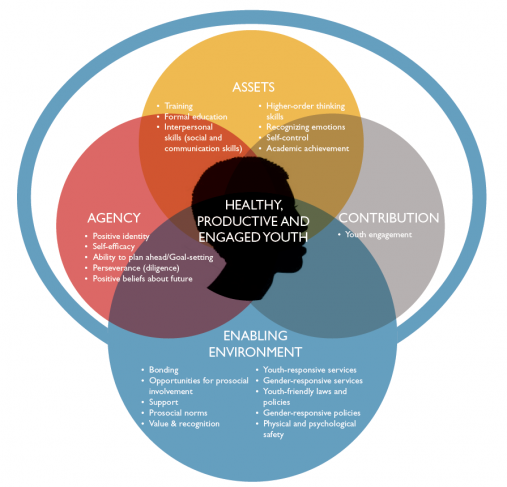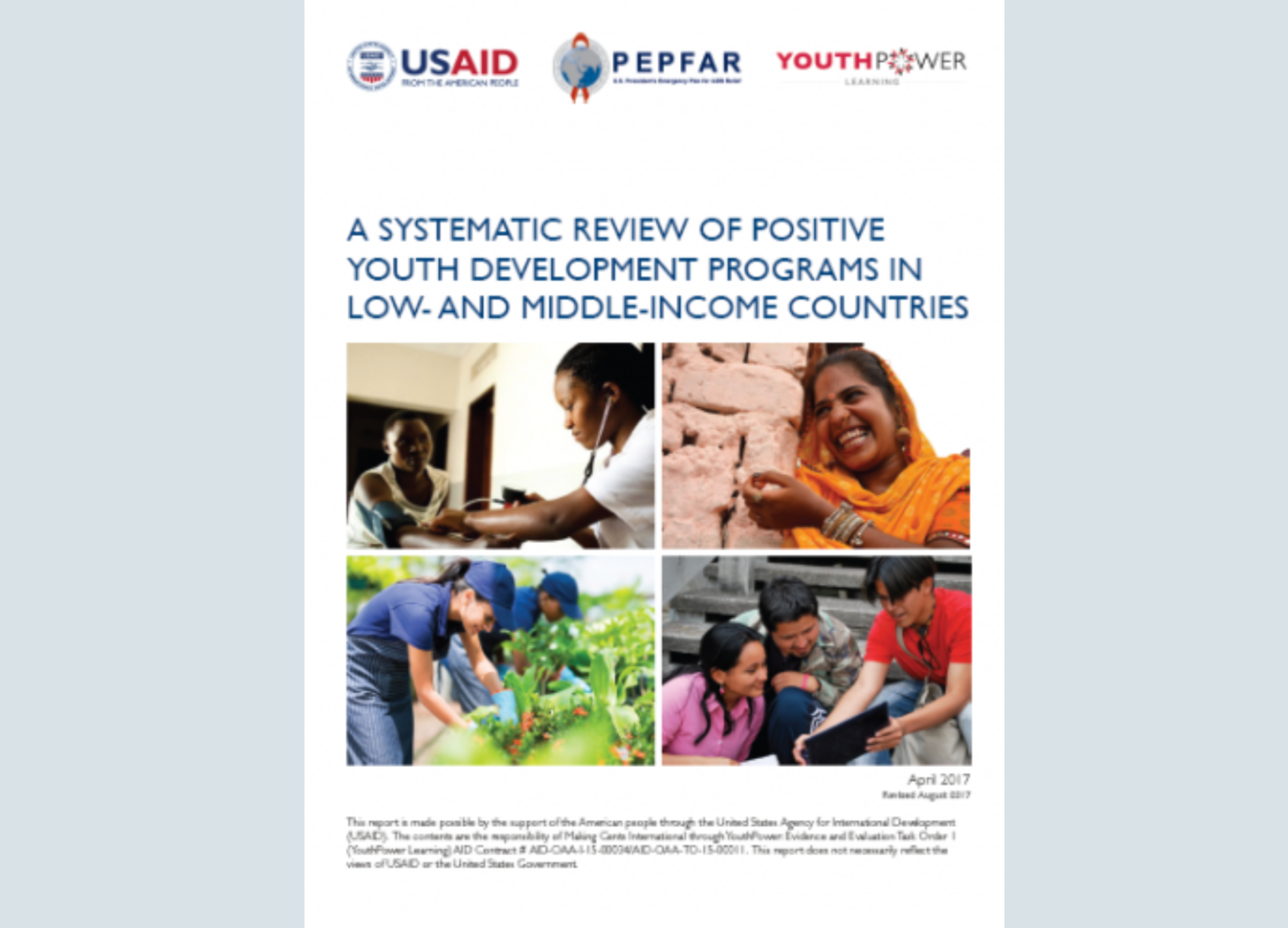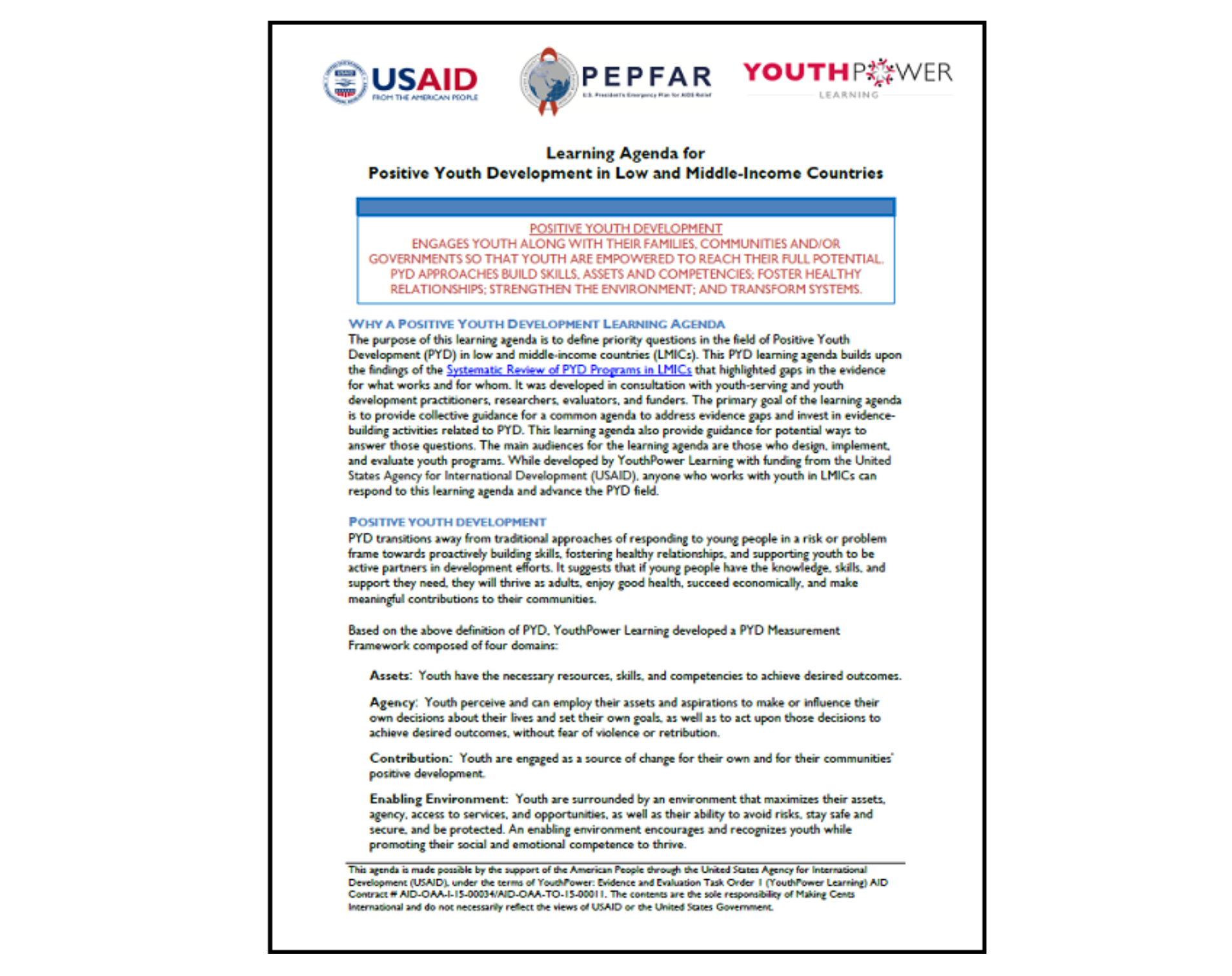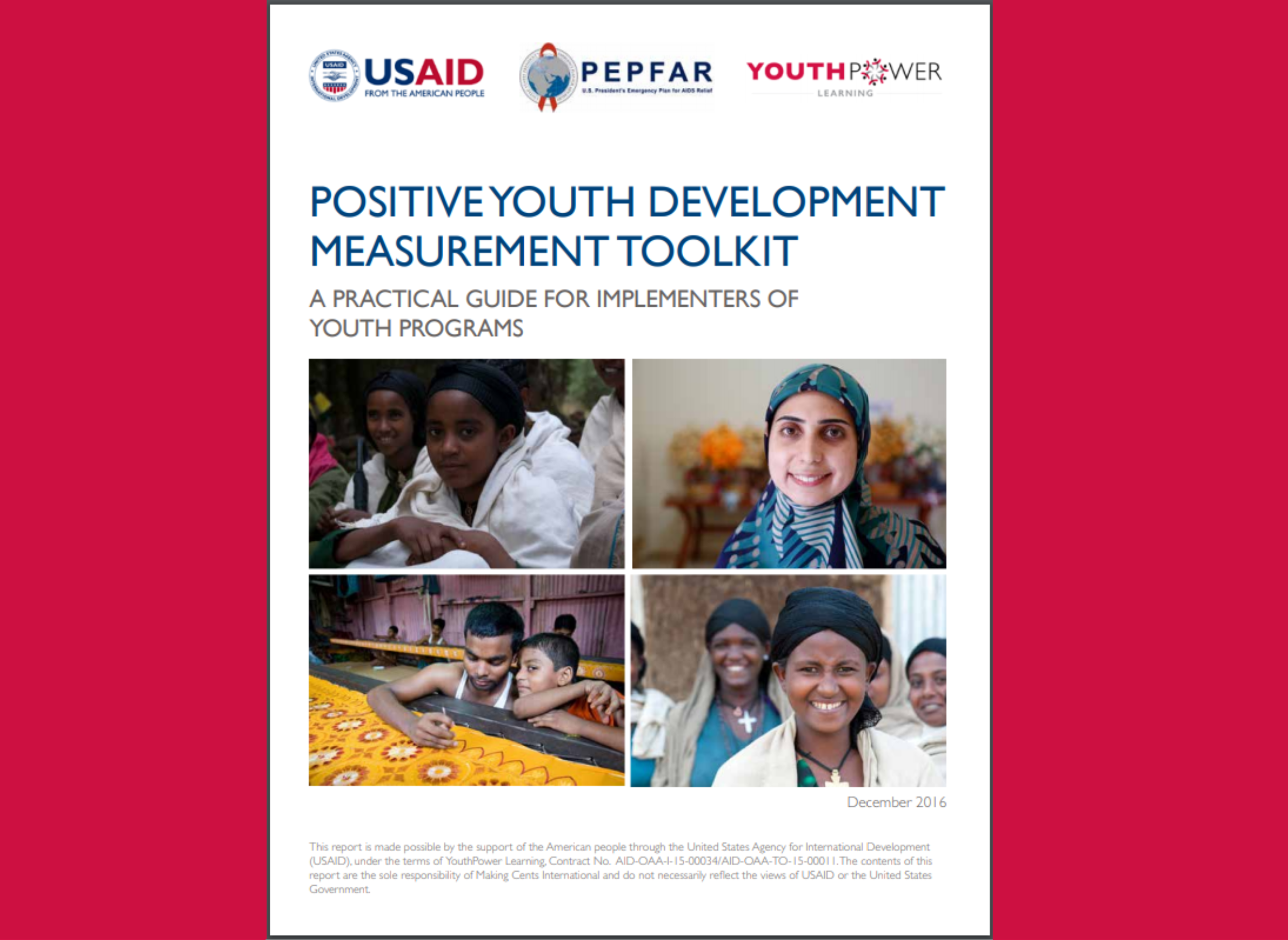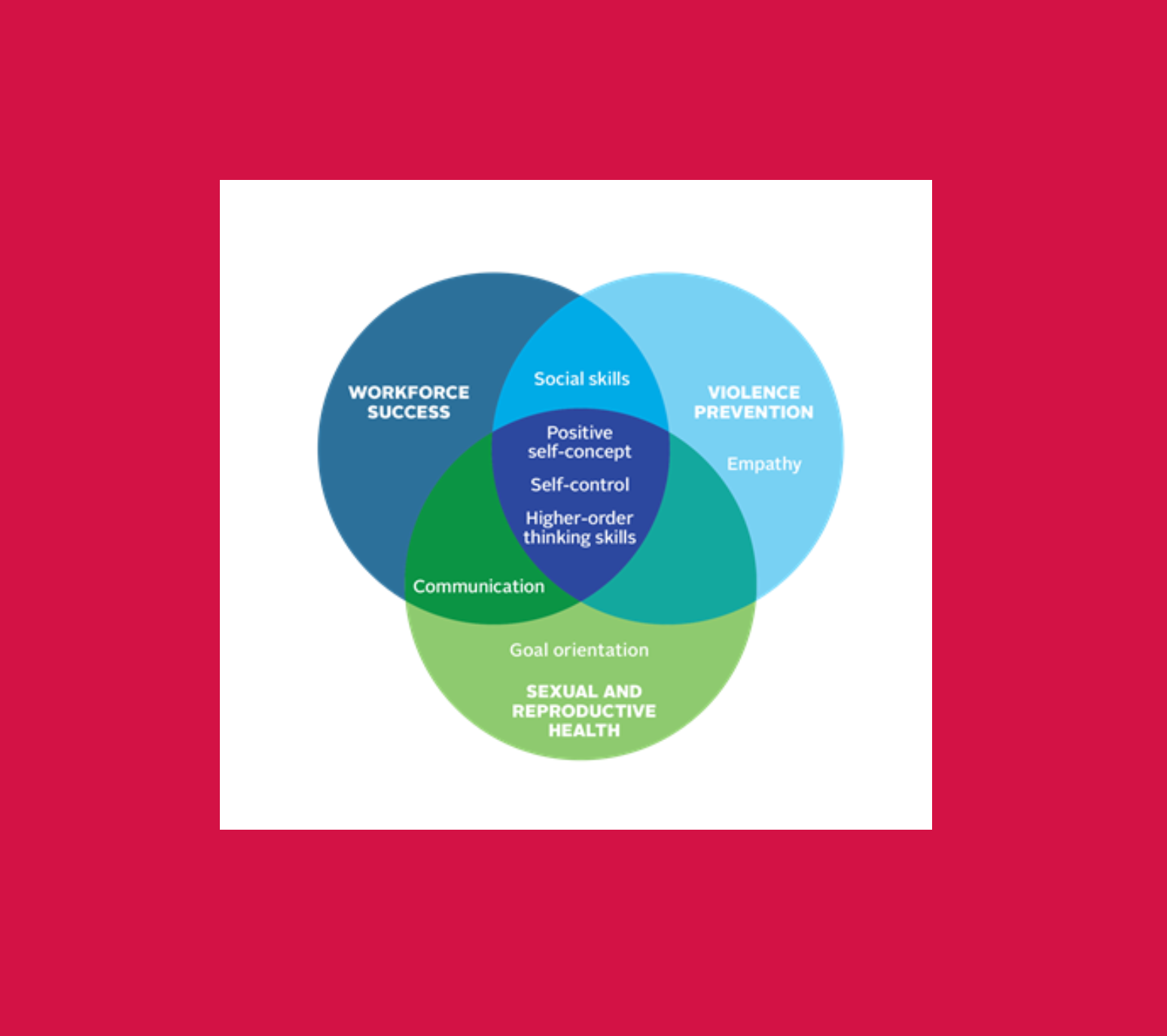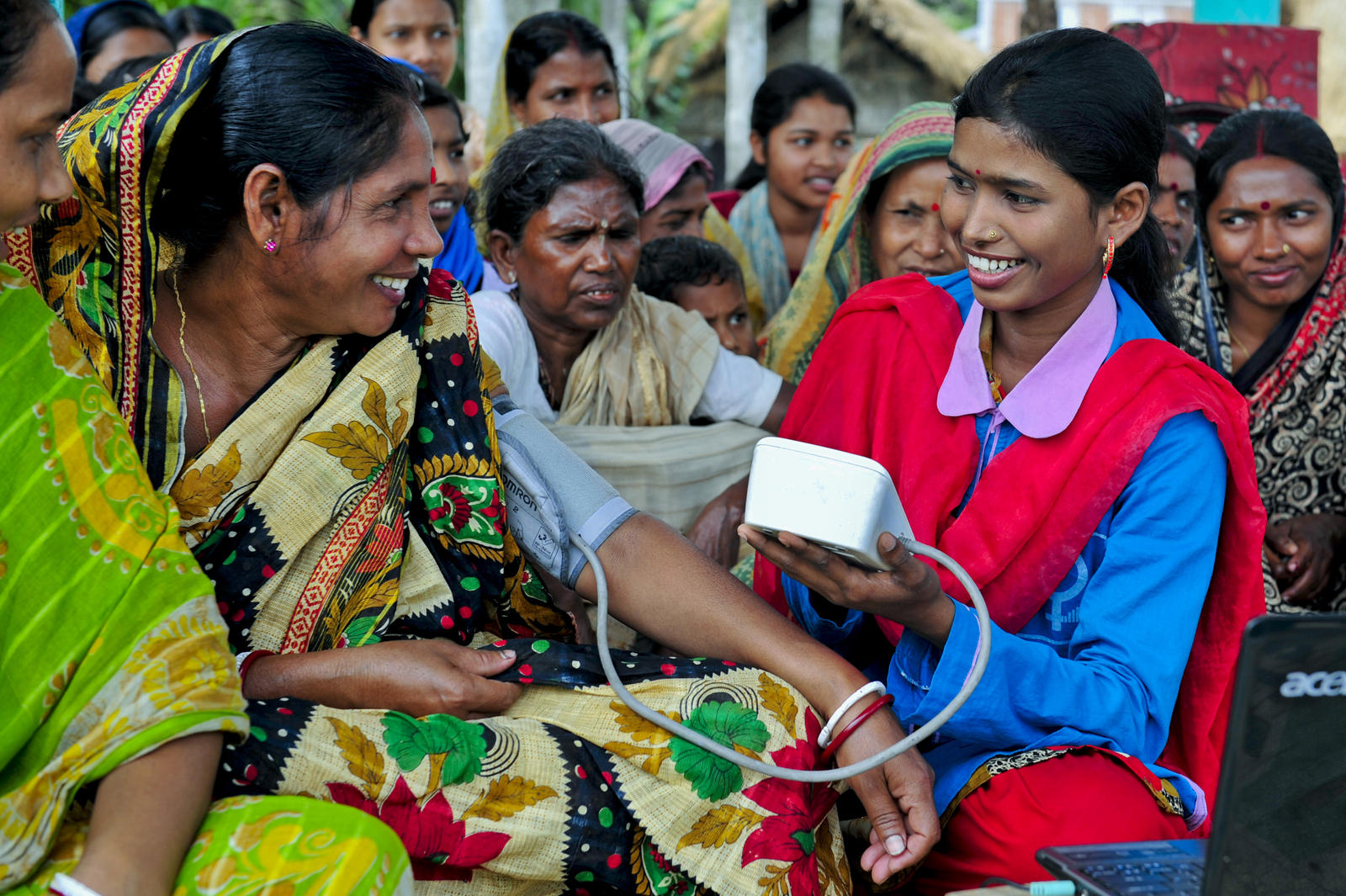
What Is Positive Youth Development?
Positive Youth Development (PYD) is both a philosophy and a programmatic approach for supporting healthy, productive, and engaged youth as they grow into adulthood. The PYD approach rests on the idea that youth with more developmental assets are more likely to enjoy academic success, have greater economic prospects, be more civically engaged, and be healthier in the long term.
While there are several definitions of PYD, USAID defines it as follows:
Positive youth development engages youth along with their families, communities, and/or governments so that youth are empowered to reach their full potential. PYD approaches build skills, assets, and competencies; foster healthy relationships; strengthen the environment; and transform systems.
Although the definition can be broadly applied across youth age groups (10 to 29), it should be noted that developmental stages of youth vary widely, and social, emotional, and cognitive skills change rapidly across these age ranges.
Because this definition is intended to be visionary and is relevant across various settings, terms like “skills,” “relationships,” “environment” and “systems” should be interpreted broadly. The terms “families,” “communities,” and “governments” are also comprehensive and encompass systems such as peer networks and educational and workplace settings.
What Is the PYD Framework?
YouthPower Learning developed an overarching PYD Framework consisting of four domains that, taken together, go to the heart of the PYD approach and are the measure of healthy, productive, and engaged youth.
PYD programs work with youth to improve their:
- Assets: Youth have the necessary resources, skills and competencies to achieve desired outcomes.
- Agency: Youth perceive and have the ability to employ their assets and aspirations to make or influence their own decisions about their lives and set their own goals, as well as to act upon those decisions in order to achieve desired outcomes.
- Enabling Environment: Youth are surrounded by an environment that develops and supports their assets, agency, access to services, and opportunities. This environment also strengthens their ability to avoid risks and stay safe, secure, and protected, as well as, live without fear of violence or retribution. An enabling environment encourages and recognizes youth, while promoting their social and emotional competence to thrive. The term “environment” should be interpreted broadly and includes: social (e.g., relationships with peers and adults), normative (e.g., attitudes, norms and beliefs), structural (e.g., laws, policies, programs services, and systems) and physical (e.g., safe, supportive spaces).
- Contribution: Youth are encouraged, recognized, and able to be involved in and lead through various channels as a source of change for their own and their communities’ positive development.
While these domains may not be relevant to the goals of all PYD programs in all contexts, they represent the high-level vision of PYD:
YouthPower Learning and YouthPower Action produced an array of additional resources to support the design, implementation, research, and evaluation of PYD programs. To learn more and gain a better understanding of how PYD applies to your work, review the resources below.
LEARN MORE ABOUT PYD
Scroll down the page to learn more and use the provided links to directly access resources of interest.
How Do We Continue To Build on What We Know About PYD?
What Features of PYD Are Essential for Strong Programs?
How Can Development Practitioners Expand Their Knowledge About PYD?
How Do We Integrate PYD Into Sector-Specific Activities?
What Are the Most Important Soft Skills for Key PYD Outcomes?
What Does PYD Mean for USAID and Its Missions?
What Do We Know About PYD?
Systematic Review of Positive Youth Development in Low- and Middle-Income Countries
The systematic review presents the results of a rigorous analysis of existing evidence of PYD in LMICs; expands the knowledge base on the impact and measurement of PYD programs; and provides valuable insights for implementing organizations, researchers, and donors.
The Systematic Review provides:
- A comprehensive framework to understanding PYD in LMICs
- Findings of how PYD has been implemented and areas in need of further investigation
- The latest evidence of what works in achieving positive youth-focused outcomes in LMICs
- Lessons learned that international implementing organizations can integrate into practice
- Recommendations to inform future program design, implementation, and evaluation efforts
How Do We Continue To Build on What We Know About PYD?
Learning Agenda for Positive Youth Development in Low and Middle-Income Countries
The Learning Agenda defines priority questions in the field of PYD in LMICs building on previously identified gaps in the evidence.. The main audiences for the learning agenda are those who design, implement, and evaluate youth programs. Anyone who works with youth in LMICs can respond to this learning agenda and advance the PYD field. The PYD learning agenda prioritizes five themes:
- Understanding how PYD programs achieve positive impact in LMICs;
- Cross-sectoral impact of PYD programs;
- Measurement of PYD constructs;
- PYD for vulnerable or marginalized populations; and
- Youth engagement in PYD programs.
Learnings already gathered are curated on the microsite. Join the call to advance our collective understanding of PYD globally.
How Do We Measure PYD?
Positive Youth Development Measurement Toolkit: A Practical Guide for Implementers of Youth Programs
The Toolkit offers guidance and resources for implementers of youth programming in LMICs to integrate PYD principles in their monitoring and evaluation systems, as well as illustrative indicators to effectively measure PYD outputs and outcomes. This Toolkit is also available in French, Arabic, and Spanish.
The main section of the Toolkit discusses PYD constructs and illustrative indicators for implementers. We take readers step by step through a series of phases that utilize the PYD Framework (including the illustrative indicators) to demonstrate how youth programs can be optimally designed using a PYD approach, and how program staff can measure PYD-related outcomes in their program to to assess impact on youth.
Finally, this Toolkit offers a series of considerations for adapting the indicators and measures to local contexts. Given that the PYD field has mostly been developed and evaluated in high-income countries, it is essential that these measures be appropriately and thoughtfully adapted to LMIC contexts to effectively evaluate youth programming in various sectors from a PYD perspective.
For additional information on the Toolkit, take a look at some Frequently Asked Questions and Answers.
What Features of PYD Are Essential for Strong Programs?
Seven features of PYD are essential for strong for programs (See Table 3). These features link directly to the four domains presented in the PYD Framework. Like the domains, these features are grounded in the literature, particularly the work of the National Research Council and Institute of Medicine, but are tailored for the context of a developing country. The PYD features can help to define what activities can be incorporated within each of the four PYD domains.
Table 3: PYD Framework Domains and PYD Program Features
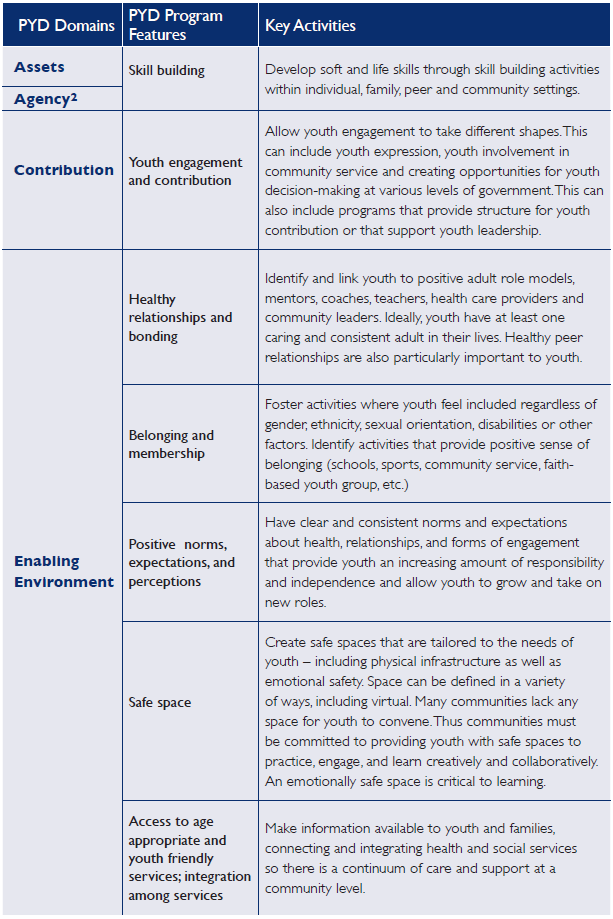
How Can Development Practitioners Expand Their Knowledge About PYD?
USAID’s PYD Courses
The PYD 101 and 201 eCourses developed by USAID are designed for development practitioners who want to build their knowledge and skills. PYD 101 covers the fundamentals and PYD 201 takes that knowledge to the next level, asking participants to apply their learning through a program design scenario.
PYD 101 course: The Fundamentals of Effective Youth Programming is for all PYD practitioners to understand the principles and practices behind effective youth programming. You will walk away from this interactive, scenario-based course with an understanding of what PYD is, the PYD domains and features, how PYD connects with and considers other sectors, and links to key resources and tools.
PYD 201 course: Applying Fundamentals of Effective Youth Programming is for PYD practitioners who are interested in taking their learning from the Positive Youth Development 101 (PYD 101) course to the next level. In this course you will walk through the steps of a youth program design and create a draft youth program design based on interactive scenarios.
How Do We Adapt PYD to Account for the Distinct and Diverse Age-Specific and Context-Specific Needs of Youth?
Building the assets and skills of adolescents has potentially both immediate and long-term positive effects on the mental and physical health, economic development, and overall well-being of adolescents, their families and communities (Patton et al., 2016). However, while the adolescent experience has many shared elements globally, there are important variations in the needs and vulnerabilities of adolescents according to age, gender, and developmental stage, as well as cultural, socio-economic and environmental factors. It is therefore crucial that interventions take into account the distinct and diverse age-specific and context-specific needs of youth to create conditions in which youth can thrive (Patton et al., 2016). There is also tremendous variation from culture to culture about whether adolescence is formally recognized as a distinct stage of life, and progression toward adulthood is often dependent on cultural and historical contexts (Patton et al., 2016). This, in part, reflects the tremendous diversity of the youth experience globally, as well as in cultural and social conceptualizations of how transitions are made between adolescence and adulthood (Crocket & Silbereisen, 2000). As a result, few programmatic and policy approaches have effectively and comprehensively addressed the needs of all youth, and rarely reach the most marginalized, including very young youth, those living in extreme poverty, married youth, out-of-school youth, and others.
USAID seeks to strengthen and ensure the effectiveness of youth programming by moving investments from single-sector, problem-focused responses toward cross-sectoral PYD investments that help countries support youth in reaching their full potential. Building on the theoretical and empirical work on positive youth development and USAID’s Youth and Development Policy, YouthPower Learning developed a conceptual framework of positive youth development that is contextually relevant and provides a basis for the use of positive indicators across multiple sectors in LMICs. A targeted PYD approach will enable USAID to understand what components work best for specific segments of youth across sectors.
How Do We Integrate PYD Into Sector-Specific Activities?
Agriculture:
The two-part Feed The Future Project Design Guide for Youth-Inclusive Agriculture and Food Systems highlights ways in which program designers can develop youth-inclusive projects and activities that account for both the diversity of the youth cohort as well as the dynamism of the agricultural sector.
Democracy, Human Rights, and Governance:
YouthPower Learning’s Toolkit for Youth Inclusion in Democracy, Human Rights, and Governance contains an array of resources for how to integrate youth effectively into programming, including modules specific to 10 sub-sectors.
Youth Workforce Development and Entrepreneurship:
The What Works in Entrepreneurship Education and Training Programs for Youth? Evidence Report summarizes the evidence for what works in youth entrepreneurship training and support interventions. The report also describes the outcomes that can reasonably be expected from entrepreneurship programs and how apply this understanding to designing and implementing future programming.
Health:
Research on Understanding and Tackling the Gendered Drivers of Poor Adolescent Mental Health includes a conceptual framework for understanding the context of adolescent mental health and two briefs that synthesize an analysis of Global School-based Health Surveys for six LMICs.
Mentoring Interventions and the Impact of Protective Assets on the Reproductive Health of Adolescent Girls and Young Women outlines types of mentoring programs for AGYW that have been shown to be effective in improving protective assets, and/or reproductive health knowledge, intentions, behaviors, or outcomes, with interventions identified.
Planning and Conducting Index Testing and Partner Notification for Adolescent Girls and Young Women: Implementation and Clinical Guidance for Health Services supports providers in conducting routine inquiries for intimate partner violence and sexual violence with adolescent girls and young women.
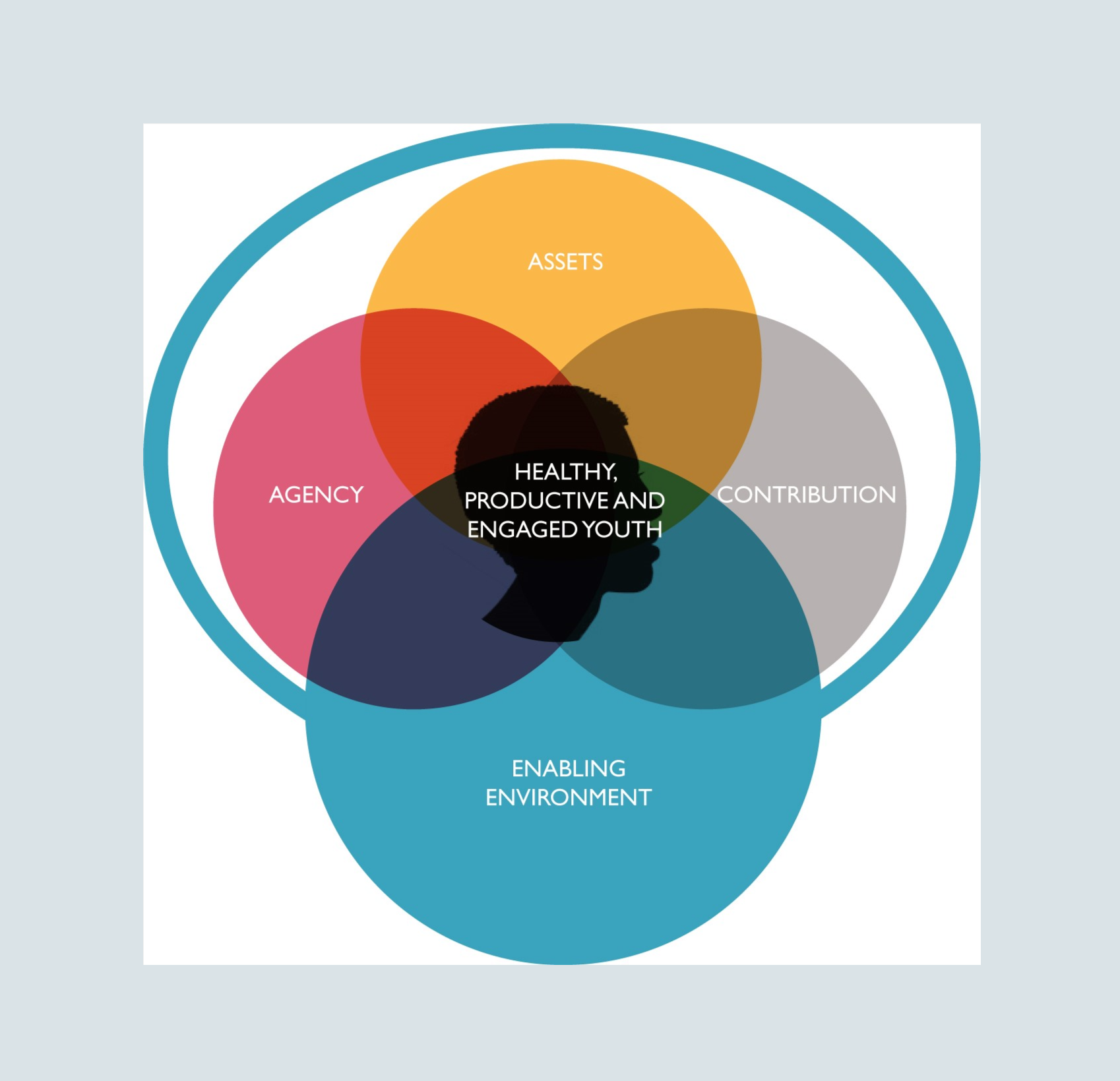
Soft Skills
The Soft Skills Research Suite microsite highlights a series of studies on soft skills for youth development that focuses on identifying the most important soft skills for key youth outcomes — including youth success in the workforce and youth violence prevention and reproductive health — analyzing instruments to measure those skills, and providing guidance on how to help adolescents and young adults build these key skills.
Soft Skills for Cross-Sectoral Outcomes Assessment: Administration Guide
Measuring Soft Skills Among Youth and Young Adults: Validation of a New Instrument
What Does PYD Mean for USAID and Its Missions?
Both the PYD field and USAID’s Youth in Development Policy recognize youth participation as vital to development. Youths’ full participation in development efforts can contribute to more sustainable investments to end cycles of poverty; to build resilient, democratic societies; to improve health and nutrition outcomes; and to strengthen economies (Scales, Roehlkepartain & Fraher, 2012). USAID Missions can enact and reinforce the broader Agency’s efforts to empower youth by advancing programs which: 1) recognize that youth participation is essential for effective programming; 2) invest in youth’s assets; 3) foster healthy relationships by involving mentors, families and communities; 4) account for differences and commonalities among youth; 5) pursue gender equality; 6) harness youth innovation and technology; and 7) create second-chance opportunities for youth. Investments in youth translate to benefits for society by increasing youth’s connections to civil society and helping youth make successful transitions to adulthood (World Bank, 2007). The PYD approach can inform evidence-based design of future USAID youth-focused programing, and it can inform evaluation design for such programs.
What Does PYD Mean for Implementers of USAID Programming?
Programs that utilize a PYD approach have increasingly demonstrated that building the intellectual, physical, social, and emotional competence of youth is a more effective development strategy than one that focuses solely on correcting problems (Scales, Roehlkepartain, & Fraher, 2012). Incorporating a PYD approach during program design and using indicators of positive development to evaluate the program can help to assess trends in positive outcomes over the life of a project. When applied across multiple projects and sectors, implementers can ensure PYD program effectiveness within and across sectors, provide evidence for increased funding, and set the stage for program sustainability and scale-up. Implementers can incorporate and measure PYD in youth programming to improve program performance over time, contribute to the body of evidence on PYD, and ultimately influence multi-sector outcomes and impact.
What are Additional Ways to Engage with PYD Activities?
-
Join YouthPower.org and receive important PYD updates.
-
Explore YouthPower Learning’s list of resources and event recordings about PYD
-
Connect with young changemakers on YouthLead
-
Contribute with research to the PYD Learning Agenda
-
Engage with YouthPower Learning 2: Learning and Evaluation

